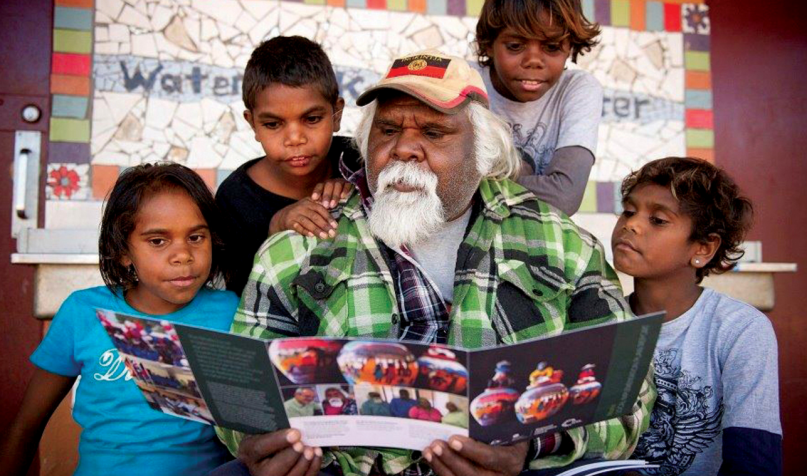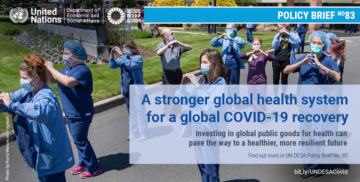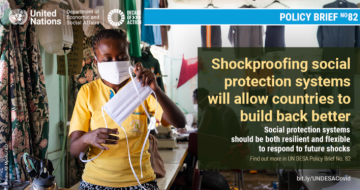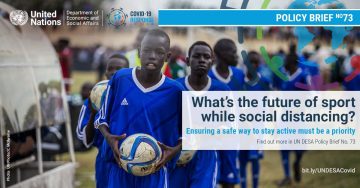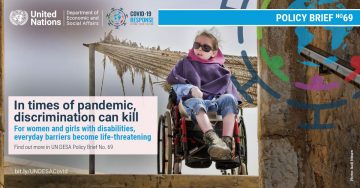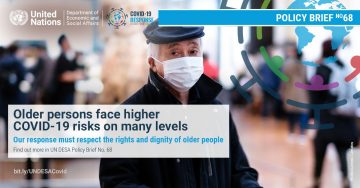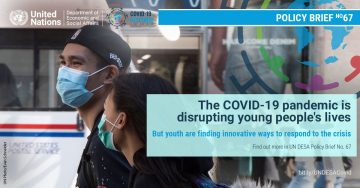Publications
Displaying 1 - 10 of 12
Policy Briefs |
PDF document available at: https://www.un.org/development/desa/dpad/wp-content/uploads/sites/45/publication/PB150.pdf
Worldwide, populations are ageing rapidly due to gains in life expectancy and declines in fertility. The trend towards a growing number and share of older persons is projected to continue in the foreseeable future. As the number of older persons grows, their socioeconomic and demographic characteristics will evolve as well, with implications for economies, societies and public budgets.
While long-term trends are hard to predict, assessing the characteristics of current and future cohorts of older persons provides important insights into the future of our ageing…
Policy Briefs |
PDF document available at: https://www.un.org/development/desa/dpad/wp-content/uploads/sites/45/publication/PB149.pdf
Introduction
Public institutions are confronted with far-reaching and complex challenges in building an inclusive and resilient post-COVID-19 society, ranging from public health and employment to education and social protection. These are coupled with other pressing challenges toward achieving the 2030 Agenda for Sustainable Development, including poverty eradication, climate change as well as energy and food crises. As governments alone cannot effectively respond to these multi-faceted challenges and “participation is a key dimension of governance and one of the…
Policy Briefs |
PDF document available at: https://www.un.org/development/desa/dpad/wp-content/uploads/sites/45/publication/PB151.pdf
Languages are one of the most significant emblems of human diversity, revealing how we can perceive, relate to, and understand the world differently. Languages are vehicles of our cultures, collective memory and values. They are an essential component of our identities.
Out of the 6,700 languages spoken worldwide, forty percent are in danger of disappearing. Indigenous Peoples make up less than 6 percent of the global population, yet they speak more than 4,000 of the world’s languages. Most of the languages that are under threat are Indigenous languages.
This…
Policy Briefs |
PDF document available at: https://www.un.org/development/desa/dpad/wp-content/uploads/sites/45/publication/PB147.pdf
Old age disadvantage begins at birth
Much of the inequality between older persons has its roots in early life conditions. Without policies to prevent it, disadvantages reinforce one another through peoples’ lives, leading to large disparities among older adults. A life course perspective on ageing is critical to improving people’s health and well-being throughout the life course into old age.
Disability as a marker of inequality at older ages
The onset and severity of disability – affecting either physical or mental health – profoundly impacts the lives of people…
Policy Briefs |
Amidst deliberations on priority areas for rebuilding, much attention has been paid to the need to strengthen domestic health care, and such proposals will certainly be high on the agenda for many Governments. The crisis, however, has also shone a spotlight on the shortcomings of the global health system.
Policy Briefs |
Risks of implementing more shock responsive social protection include overwhelming demand, lack of coordination, poor targeting and negative public perception. These can be partially offset by ensuring universal access to programmes. A country’s available fiscal space and level of debt distress are key contextual factors that determine the feasibility of more shock-responsive social protection.
Policy Briefs |
Introduction
Sport is a major contributor to economic and social development. Its role is well recognized by Governments, including in the Political Declaration of the 2030 Agenda, which reflects on “the contribution sports make to the empowerment of women and of young people, individuals and communities, as well as to health, education and social inclusion objectives.”
Since its onset, the COVID-19 pandemic has spread to almost all countries of the world. Social and physical distancing measures, lockdowns of businesses, schools and overall social life, which have become commonplace to curtail the spread of the disease, have also disrupted many regular aspects of life, including sport and…
Policy Briefs |
Persons with disabilities—both visible and invisible—face obstacles and discrimination in accessing health care and other essential services, social protection and income security, mental health services, and communication technologies. In addition, women and girls with disabilities are subject to intersecting forms of discrimination related to sexual and reproductive health, gender-based violence, legal protection, unpaid care and domestic work. Women and girls with disabilities who are migrants, refugees, or from ethnic minorities endure even more hardships and unequal treatment. Gender, disability and structural inequalities, which characterized societies before the crisis, are being…
Policy Briefs |
As the world grapples with an unparalleled health crisis, older persons have become one of its more visible victims. The pandemic spreads among persons of all ages and conditions, yet available evidence indicates that older persons and those with underlying medical conditions are at a higher risk of serious illness and death from the COVID-19 disease.
Often, chronic health conditions are more prevalent in old age; increasing risks for older adults. The World Health Organization has reported that over 95 per cent of fatalities due to COVID-19 in Europe have been persons aged 60 years or older. Several sources suggest that as data from fatalities in nursing homes become available, the death…
Policy Briefs |
Socioeconomic impacts
Prior to the onset of COVID-19, youth (aged 15 to 24) were already three times more likely to be unemployed compared to adults, while 126 million young workers were in extreme and moderate poverty worldwide (International Labour Organization, 2020). Young workers are also more likely to be in precarious employment than other age groups. Whereas some 77 per cent of youth are estimated to be informally employed globally, this percentage is even higher for young women in low and lower-middle-income countries (International Labour Organization, 2018).
The increase in unemployment as a result of COVID-19 is expected to exceed the rise in rates of unemployment in the…
 Welcome to the United Nations
Welcome to the United Nations


